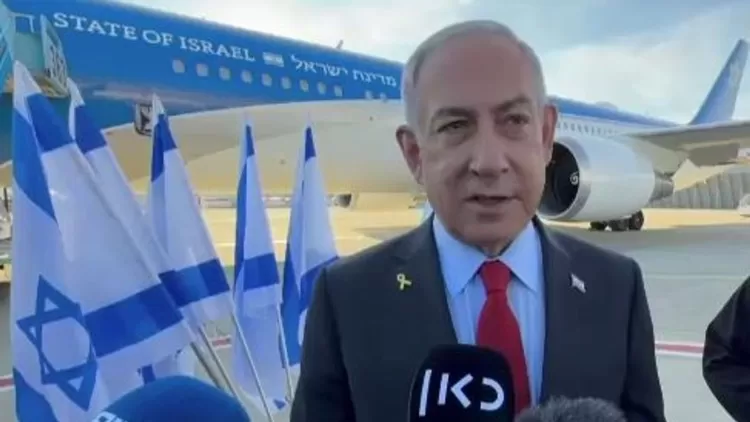Netanyahu’s Washington Visit: Talks on Gaza Truce, Hostages, and Iran
Israeli Prime Minister Benjamin Netanyahu’s visit to Washington comes as Israel and Hamas prepare for phase two of their truce talks. Netanyahu and President Trump will discuss key issues, including victory over Hamas, the release of hostages, and countering Iran. Meanwhile, the Israeli military escalates actions in Gaza and the West Bank, as tensions rise in Lebanon.

Context & Background: A Critical Diplomatic Meeting
Israeli Prime Minister Benjamin Netanyahu has arrived in Washington for a key meeting with U.S. President Donald Trump, scheduled for tomorrow. Before departing for the U.S. capital, Netanyahu outlined the major topics of discussion: Israel’s victory over Hamas, securing the release of all remaining hostages held in Gaza, and countering the growing influence of Iran and its proxies in the region.
This visit is crucial as it comes at a time when Israel and Hamas are engaging in the second phase of ceasefire negotiations, which aim to secure further hostage releases and discuss the long-term resolution of the ongoing conflict. Netanyahu’s office confirmed that he will first meet with U.S. envoy Steve Vitkoff before sitting down with President Trump. The talks between Netanyahu and Vitkoff are expected to focus on advancing the negotiations for the next stage of the Gaza truce.
Main Developments: Ceasefire Negotiations and Hostage Releases
The first phase of the Gaza truce, which began in mid-January, will come to an end next month, and the second phase is expected to tackle more significant issues, including the release of the remaining hostages held by Hamas. To date, 18 Israeli hostages have been freed since the ceasefire agreement came into effect on January 19, following the release of over 180 Palestinian prisoners by Israel. In exchange, Hamas released three Israeli hostages on Saturday.
The timing of these negotiations is crucial, as the ongoing hostage exchanges and truce talks have brought some temporary relief, but the pressure to reach a lasting peace deal remains high. Netanyahu’s office confirmed that Vitkoff will first meet with Egyptian mediators before discussing the next steps with Netanyahu. The key discussions will include setting a date for formal negotiations between delegations from both Hamas and Israel.
However, not all members of Israel's governing coalition are supportive of the ceasefire talks. Finance Minister Bezalel Smotrich has warned that he will quit the government if the war does not resume, potentially stripping Netanyahu of his majority. Smotrich’s stance reflects the deep political divisions within Israel’s leadership on how to handle the ongoing conflict.
Israeli Military Actions: Escalation in Gaza and the West Bank
As negotiations continue, Israel’s military has shifted focus back to the West Bank, where it has carried out significant operations in recent days. The Israeli military has destroyed nearly two dozen buildings in the Janine area, which they claim were being used as terrorist infrastructure. This move has been met with strong condemnation from the Palestinian Foreign Ministry, which called it a “brutal scene” and a violation of international law.
At the same time, Israel has missed a critical deadline to complete its withdrawal from the southern part of Lebanon, as required by the 26th January deadline. In response, Hezbollah leader Hassan Nasrallah has called on the Lebanese authorities to press Israel to cease its fire violations along the border. This delay in withdrawal has fueled tensions in the region, particularly in the context of Israel’s ongoing campaign against Hezbollah, which has been marked by cross-border hostilities for nearly a year.
Lebanon: Tensions and Leadership Changes
In Lebanon, the situation remains tense as Israel’s actions continue to provoke responses from Hezbollah. The group, which has been engaged in a long-standing conflict with Israel, is mourning the deaths of key leaders. Hassan Nasrallah’s predecessor, Nasserallah, was killed in a massive Israeli airstrike on Beirut’s southern suburbs on September 27, and Hezbollah confirmed that Nasrallah’s successor, Hashim Safin, was also killed in October. The group has announced that both leaders will be buried on the same day, symbolizing the ongoing struggle and the high stakes of the Lebanese-Israeli conflict.
This ongoing volatility underscores the precarious situation in the region, where both Hezbollah and Israel continue to be on high alert, with the risk of escalation growing as tensions over military withdrawals and border violations mount.
A Region on the Brink of Change
As Netanyahu heads to Washington to meet with President Trump, the discussions on Gaza, hostages, and Iran will likely shape the future trajectory of the region. The second phase of the Gaza ceasefire talks will focus on the release of more hostages and efforts to bring a permanent end to the war. Meanwhile, tensions between Israel and Hezbollah continue to rise, with political instability within Israel itself adding another layer of complexity to the situation.
The outcome of Netanyahu’s meetings in Washington could have far-reaching consequences not only for Israel and Hamas but for the broader Middle Eastern geopolitical landscape. With internal divisions within Israel’s government and mounting challenges on the military front, Netanyahu faces the difficult task of balancing diplomatic efforts with the security concerns of his nation. The coming days will be critical in determining whether the truce can evolve into a more lasting peace or if the region will be drawn into further conflict.
What's Your Reaction?















